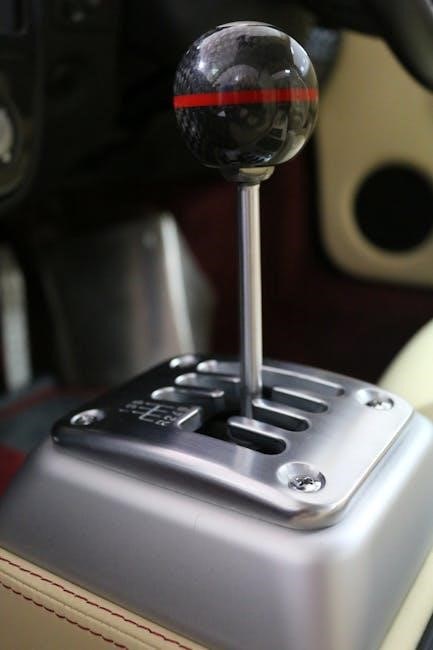how long does it take to learn manual driving
Summary
Discover the average time it takes to master manual driving and tips to learn faster!

Mastering manual driving typically takes a few weeks to a couple of months‚ depending on practice frequency and individual skill level. Consistent practice accelerates progress.
What is Manual Driving?
Manual driving involves operating a vehicle with a manual transmission‚ requiring the use of a clutch pedal and gearshift to change gears. Unlike automatic cars‚ manual driving demands active engagement‚ as the driver must coordinate the clutch‚ accelerator‚ and gearshift to control speed and torque. This method offers greater control over the vehicle‚ especially in varying driving conditions. The clutch pedal disconnects the engine from the transmission‚ allowing gear changes‚ while the gearshift selects the appropriate gear for the vehicle’s speed. Manual driving is popular worldwide due to its fuel efficiency and driving precision. It requires practice to master smooth transitions between gears and clutch control‚ which are essential for avoiding stalling and ensuring smooth acceleration. Consistent practice helps drivers develop muscle memory and improve their overall driving skills.
Why Learn Manual Driving?
Learning manual driving offers numerous benefits‚ including greater control over the vehicle‚ improved fuel efficiency‚ and enhanced driving skills. Manual transmissions are often more cost-effective to purchase and maintain compared to automatics. Additionally‚ understanding how to drive a manual car provides versatility‚ as many vehicles worldwide still use manual transmissions. It also fosters a deeper connection to the driving experience‚ making it more engaging and enjoyable. Mastering manual driving demonstrates discipline and coordination‚ as it requires synchronizing the clutch‚ accelerator‚ and gearshift. This skill can also improve safety‚ as it demands active awareness and attention while driving. Overall‚ learning manual driving is a valuable skill that can be mastered with practice‚ offering long-term benefits for drivers of all levels.

Understanding the Basics of Manual Transmission
Manual transmission involves using a clutch pedal and gearshift to manually change gears‚ providing control over speed and torque. The clutch disconnects the engine from the transmission‚ allowing smooth gear shifts.
Components of a Manual Transmission System
A manual transmission system consists of several key components that work together to enable gear changes. The clutch is a friction plate that engages and disengages the engine from the transmission. The gearbox contains gears that provide different speed ratios‚ allowing the vehicle to accelerate efficiently. The gearshift‚ located on the center console‚ is used to manually select the desired gear. The flywheel is attached to the engine’s crankshaft and works with the clutch to transfer power. The pressure plate holds the clutch disc against the flywheel‚ while bearings and synchros facilitate smooth gear transitions. Together‚ these components enable drivers to control speed and torque‚ making manual driving precise and engaging.
How the Clutch and Gear System Works
The clutch and gear system in a manual transmission operates by disconnecting and reconnecting the engine from the transmission. Pressing the clutch pedal disengages the engine‚ allowing the driver to shift gears without resistance. The gearbox contains multiple gears that provide different speed ratios‚ enabling the vehicle to accelerate efficiently. The gearshift is used to select the desired gear‚ while the clutch pedal controls the connection between the engine and the transmission. When the clutch is released slowly‚ the engine reconnects with the transmission‚ and the selected gear engages. Proper coordination between the clutch and accelerator pedals is essential for smooth acceleration and gear changes. Mastering this coordination typically takes a few weeks to a couple of months with consistent practice.

The Role of Practice in Learning Manual Driving
Consistent practice is crucial for mastering manual driving‚ as it builds muscle memory and smooth coordination between clutch and accelerator‚ accelerating the learning process effectively.
Importance of Consistent Practice
Consistent practice is essential for mastering manual driving‚ as it helps develop muscle memory and coordination between the clutch and accelerator. Regular sessions‚ even short ones‚ ensure steady progress and reduce the likelihood of stalling. Over time‚ learners gain smoother gear transitions and better control over the vehicle. Practice also builds confidence‚ allowing drivers to handle various road conditions more effectively. Without consistent effort‚ skills may plateau‚ making it harder to achieve proficiency. By dedicating time daily or several times a week‚ learners can accelerate their learning curve and become comfortable with manual driving mechanics. Additionally‚ practicing in different environments‚ like empty parking lots or quiet streets‚ reinforces adaptability and overall mastery.
Best Practices for Effective Practice Sessions
To maximize progress in manual driving‚ practice sessions should be structured and focused. Start in a flat‚ empty area like a parking lot to build foundational skills without distractions. Gradually incorporate inclines to master clutch control. Practice shifting gears smoothly at appropriate speeds‚ using the tachometer as a guide. Regularly review your driving footage to identify and correct mistakes. Stay mentally prepared by setting specific goals for each session. Keep sessions short to maintain concentration and avoid fatigue. Use mirrors effectively to stay aware of surroundings. Stay relaxed to avoid unnecessary wear on the clutch. Regularly review progress to adjust practice accordingly.
Factors Influencing the Learning Curve
The learning curve for manual driving is influenced by prior driving experience and the frequency of practice sessions. Consistent practice and quality instruction shape progress effectively.
Previous Driving Experience
Drivers with prior experience in automatic vehicles often adapt to manual driving faster‚ as they already understand basic driving mechanics. This foundation allows them to focus solely on mastering the clutch and gear shifting. For instance‚ a driver familiar with acceleration control and braking techniques can quickly apply these skills to manual driving. Their ability to coordinate actions reduces the learning period significantly. Conversely‚ new drivers without any experience may take longer‚ as they must learn both driving fundamentals and manual transmission skills simultaneously. Experience behind the wheel directly correlates with a smoother transition to manual driving‚ making prior knowledge a key factor in the learning timeline.
Frequency and Quality of Practice
The frequency and quality of practice sessions significantly impact the time it takes to learn manual driving. Regular‚ consistent practice helps develop muscle memory and improves coordination between the clutch and accelerator. Even short‚ focused sessions of 20-30 minutes daily can lead to quicker mastery compared to infrequent‚ longer practices. Additionally‚ the quality of practice matters; focusing on specific skills‚ such as smooth shifting or starting on inclines‚ yields better results than random driving. A structured approach ensures that learners progressively build their skills‚ reducing the overall learning time. Combining consistent practice with targeted exercises accelerates proficiency‚ making it essential for learners to prioritize both frequency and quality in their practice routine.

Key Skills to Master in Manual Driving
Mastering manual driving requires honing clutch control and smooth shifting‚ which are essential for seamless gear transitions and maintaining vehicle momentum. These skills take time and practice to perfect.
Clutch Control and Smooth Shifting
Clutch control and smooth shifting are fundamental skills in manual driving‚ requiring coordination between the clutch pedal and accelerator. Proper technique ensures seamless gear transitions‚ avoiding jerks or stalls. Learners often struggle initially‚ but consistent practice builds muscle memory and fluidity. The key is gradual clutch release while pressing the accelerator‚ maintaining vehicle balance. Smooth shifting is critical for maintaining momentum‚ especially on inclines or in traffic. Over time‚ drivers develop the ability to anticipate gear changes‚ enhancing control and comfort. Mastering these skills reduces wear on the transmission and improves overall driving efficiency‚ making manual driving both enjoyable and effective in various conditions.
Starting on an Incline and Stopping
Mastering starts on inclines and smooth stopping is essential for manual driving proficiency. On an incline‚ balancing clutch release with accelerator input prevents rolling backward. Use the handbrake for added safety. When stopping‚ downshift before coming to a halt to control speed and avoid wear on the brakes. Practice gradual clutch engagement and disengagement to maintain balance. Smooth transitions reduce jerking and enhance control. These techniques take time to refine but are critical for safe and confident driving. Consistent practice in varied terrains helps develop the muscle memory needed for effortless starts and stops on any gradient.

Common Challenges Faced by Learners
Common challenges include stalling‚ mastering clutch control‚ and achieving smooth shifts. Consistent practice helps learners overcome these hurdles and build confidence over time.
Stalling the Car and How to Recover
Stalling is a common issue for learners‚ often due to improper clutch control or insufficient acceleration. To recover‚ press the clutch‚ shift to neutral‚ restart the engine‚ and slowly release the clutch while accelerating gently. Practicing in a safe‚ flat area helps build muscle memory and reduces stalling frequency. Over time‚ learners develop the ability to smoothly transition between gears and maintain momentum‚ minimizing stalls. Consistent practice and patience are key to overcoming this challenge and becoming a confident manual driver.
Riding the Clutch and Acceleration
Riding the clutch‚ or keeping it partially pressed‚ is a common mistake that can hinder progress in learning manual driving. This habit causes unnecessary wear on the clutch and makes smooth gear transitions difficult. To avoid this‚ focus on fully releasing the clutch pedal once the car starts moving and use it only when shifting gears. Proper acceleration is key to maintaining control. As you release the clutch‚ gradually press the accelerator to avoid jerky starts. Practice in a flat‚ open area to build muscle memory and coordination between clutch release and acceleration. Over time‚ this will become second nature‚ reducing stalling and improving overall driving smoothness. Consistent practice is essential to master this skill.

Advanced Techniques for Proficiency
Mastering advanced techniques like smooth gear shifting and downshifting enhances control and efficiency. These skills typically require consistent practice over several weeks to refine.
Shifting Gears at the Right Speed
Shifting gears at the right speed is crucial for smooth acceleration and maintaining control. Proper timing ensures the engine operates within optimal RPM ranges‚ reducing wear and tear. Matching gear shifts to driving conditions‚ such as uphill climbs or merging onto highways‚ enhances efficiency. With practice‚ drivers develop a feel for when to shift‚ based on engine sound and vehicle speed. Consistent practice over weeks helps refine this skill‚ leading to seamless transitions and improved fuel efficiency. Over time‚ shifting becomes second nature‚ allowing drivers to focus on overall vehicle control and safety.
Downshifting and Braking Techniques
Mastering downshifting and braking techniques is essential for safe and efficient manual driving. Downshifting before braking helps maintain control and reduces wear on the brake system. It involves shifting to a lower gear to slow the vehicle naturally‚ especially when descending hills or approaching stops. Proper timing and smooth transitions are key to avoiding abrupt deceleration. With consistent practice‚ most learners grasp these techniques within a few weeks to a month. However‚ refining them to instinctive levels takes longer‚ typically several months of regular driving. Effective downshifting and braking not only enhance safety but also improve fuel efficiency and overall driving smoothness‚ making them critical skills for any manual driver to master.

Learning Manual Driving in Different Environments
Adapting to urban and rural settings influences learning speed. Urban areas with heavy traffic and frequent stops may slow initial progress‚ while rural roads offer space to practice shifting and speed control‚ aiding quicker mastery of manual driving fundamentals.
Driving in Urban vs. Rural Areas
Driving in urban and rural areas presents distinct challenges that influence the learning curve for manual driving; Urban environments‚ with their heavy traffic‚ frequent stops‚ and tight spaces‚ demand quicker reflexes and smoother clutch control. Learners may initially find it challenging to master seamless gear shifts in stop-and-go traffic‚ potentially slowing progress. Conversely‚ rural areas offer open roads with fewer interruptions‚ allowing learners to practice shifting gears at various speeds and mastering clutch control in a more relaxed setting. This contrast highlights how different environments can impact the time it takes to become proficient in manual driving‚ with rural settings often fostering faster confidence and skill development compared to the complexities of urban driving.
Navigating Traffic and Intersections
Navigating traffic and intersections while learning manual driving adds complexity to the process. In urban areas‚ learners must manage frequent stops‚ tight spaces‚ and merging lanes‚ requiring precise clutch and gear control. Smooth shifting is crucial to avoid stalling‚ especially in heavy traffic or uphill starts. Intersections demand quick decisions‚ such as accelerating after a stop or downshifting before turning‚ which can be challenging for beginners. Rural intersections‚ while less congested‚ often involve higher speeds and longer distances‚ testing gear shifting accuracy. Mastering these scenarios takes time‚ as learners must coordinate clutch control with accelerating and braking seamlessly. Consistent practice in both environments helps build the muscle memory and confidence needed to navigate traffic efficiently.

Time Estimates for Mastery
Mastering manual driving typically takes 1-3 months with consistent practice. Regular sessions accelerate skill development‚ while individual progress may vary based on frequency and dedication.
Short-Term Goals and Milestones
Learning manual driving involves setting achievable short-term goals to track progress. Initially‚ focus on mastering the clutch and accelerator coordination‚ ensuring smooth starts without stalling. Within the first week‚ aim to comfortably shift gears while stationary. Gradually progress to moving in a straight line‚ practicing seamless transitions between gears. By the second week‚ work on stopping and starting on inclines‚ a critical skill for control. Consistent practice sessions of 30 minutes‚ 3-4 times a week‚ can lead to noticeable improvement. Milestones include stalling less frequently‚ shifting gears smoothly‚ and maintaining control in various conditions. Celebrate small victories‚ like driving confidently in a parking lot or navigating quiet streets‚ to stay motivated and build confidence behind the wheel.
Long-Term Proficiency and Confidence
Achieving long-term proficiency in manual driving requires consistent practice over several months. Most learners gain confidence and smooth control within 6-12 months‚ depending on frequency and quality of practice. During this period‚ drivers master advanced techniques like downshifting‚ braking smoothly‚ and navigating varied conditions. Proficiency grows as muscle memory develops‚ allowing seamless gear transitions and clutch control. Long-term confidence is built by handling diverse environments‚ such as urban traffic and rural roads‚ with ease. Regular practice reinforces skills‚ reducing stalling and improving overall vehicle control. Over time‚ drivers anticipate situations better‚ like merging onto highways or stopping unexpectedly‚ showcasing their mastery of manual driving. This long-term dedication leads to a comfortable and enjoyable driving experience.

Resources and Tools for Learning
Online tutorials‚ video guides‚ and driving instructors provide structured learning. Practice vehicles and step-by-step resources help learners master manual driving efficiently‚ ensuring progress and confidence behind the wheel.
Online Tutorials and Video Guides
Online tutorials and video guides are invaluable for mastering manual driving. They provide step-by-step instructions‚ covering clutch control‚ gear shifting‚ and real-world scenarios. These resources often include demonstrations and tips from experienced instructors‚ making complex techniques easier to understand. Videos on starting uphill‚ stopping smoothly‚ and handling various driving conditions are particularly useful. Additionally‚ many tutorials offer interactive elements‚ such as quizzes and practice exercises‚ to reinforce learning. By following these guides‚ learners can build confidence and improve their skills at their own pace. Regular use of these tools can significantly reduce the time it takes to become proficient in manual driving‚ ensuring a solid foundation for real-world practice.
Driving Instructors and Practice Vehicles
Driving instructors and practice vehicles are essential for mastering manual driving. Professional instructors provide personalized feedback‚ helping learners grasp clutch control‚ smooth shifting‚ and other critical skills. They create structured lessons tailored to individual progress‚ ensuring consistent improvement. A suitable practice vehicle‚ such as a standard transmission car with a forgiving clutch‚ allows learners to apply techniques without fear of damaging the vehicle. Regular access to a practice car builds muscle memory and confidence. Instructors can also address specific challenges‚ like starting on inclines or handling heavy traffic‚ which accelerates the learning process. With guidance from an instructor and ample practice‚ most learners can become proficient in manual driving within a few weeks to a couple of months.

Psychological Aspects of Learning
Building confidence and managing frustration are crucial in learning manual driving. Stay calm and patient‚ as stress can hinder progress. Celebrate small milestones to maintain motivation and reduce anxiety‚ fostering a positive mindset that accelerates the learning process.
Building Confidence Behind the Wheel
Building confidence while learning manual driving is essential for progress. Start in a safe‚ open space like an empty parking lot to practice basic maneuvers without pressure. Gradually expose yourself to more challenging situations‚ such as inclines or light traffic‚ as your skills improve. Celebrate small victories‚ like smooth shifts or mastering starts on an incline‚ to reinforce positive experiences. A patient instructor or practice partner can provide encouragement and constructive feedback. Over time‚ consistent practice and overcoming challenges will help you feel more comfortable and assured behind the wheel‚ reducing anxiety and boosting your overall confidence in handling a manual transmission vehicle effectively.
Managing Frustration and Stress
L earning manual driving can be frustrating‚ especially when stalling or struggling with smooth shifts. It’s important to stay calm and patient. Break the process into manageable steps‚ focusing on one skill at a time. Acknowledge that setbacks are part of the learning curve and don’t define your overall progress. Taking regular breaks can help prevent frustration from building up. Positive self-talk and celebrating small improvements can boost morale. A supportive environment‚ whether from an instructor or practice partner‚ also plays a key role in managing stress. Remember‚ consistency and persistence are key to overcoming challenges and mastering manual driving effectively.
Mastering manual driving requires patience‚ consistent practice‚ and dedication. With regular effort‚ most learners achieve proficiency within a few weeks to a couple of months. Stay motivated!
Summarizing the Learning Process
Learning manual driving is a gradual process that varies in duration depending on individual skill levels and practice consistency. Most learners achieve basic proficiency within a few weeks‚ mastering clutch control and smooth shifting. Progression includes understanding gear systems‚ starting on inclines‚ and handling various driving conditions. With consistent practice‚ learners transition from stalling frequently to confidently navigating traffic and complex situations. Advanced techniques like downshifting and braking refinement come with time and experience. The learning curve is influenced by factors such as prior driving experience and the frequency of practice sessions. Patience and dedication are key‚ as mastering manual driving is a skill that improves over time with the right approach and mindset.
Motivation for Continuous Improvement
Motivation plays a crucial role in mastering manual driving‚ as consistent practice and a positive mindset are essential for progress. Celebrating small milestones‚ like smoother shifts or confident starts on inclines‚ helps build confidence and keeps learners engaged. Setting realistic goals and tracking improvement over time reinforces the desire to continue learning. Additionally‚ understanding the practical benefits of manual driving‚ such as better control and fuel efficiency‚ can serve as a strong motivator. Feedback from instructors or experienced drivers also fosters determination. Remember‚ improvement is a gradual process‚ and staying motivated ensures long-term success and enjoyment behind the wheel.